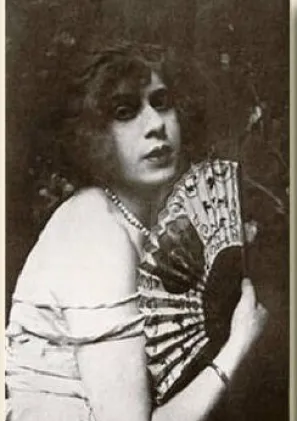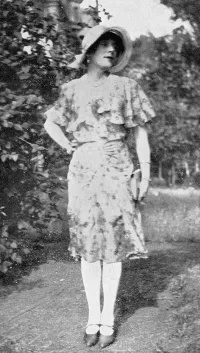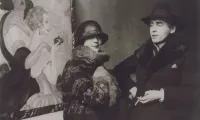Biography
1882 - 1931
"Our assumption as a society that our sex category whether we have male or female genitals has implications to what we would love, what we would like to do and what type of person we will be that also people come in two types, male nature and female nature, this has no scientific basis and people are very different from each other so I try to move from the language of the two sexes are similar or different, to language which means we are all different.”
- Lili Elbe
Einar Wegener identified as male most of his life. In 1904, he married Gerda, whom he met at Copenhagen Art School, and the couple moved to France to work as illustrators - Einar specializing in landscapes and Gerda illustrating books and fashion magazines. When a model failed to show for a session, Gerda convinced Einar to wear stockings and heels so she could finish the drawing. “Lili” was born. Lili’s newfound identity allowed her to disappear into the streets of Paris where her face and body enabled her to pass as a woman. During this period Lili’s two identities tried to coexist but this proved untenable. In 1930, she began her medical transition with the first of many gender confirmation surgeries. The first procedure was performed under the supervision of famed sexologist Dr. Magnus Hirschfeld in Berlin. The numerous surgeries which followed were undertaken at the Dresden Women’s Clinic. It was there that the discovery of rudimentary female sexual organs, and the presence of elevated female hormones, prompted her doctors to classify Elbe as “intersex.” After her gender confirmation surgery made Lili a headline sensation, the King of Denmark was convinced to invalidate her wedding to Gerda. This cleared the way for Lili to wed her new male fiancé. Sadly, during a 1931 surgical transplant of uterine tissue to create a vagina, she died from the consequences of tissue rejection before they were able to marry. Man Into Woman (1933), Elbe’s groundbreaking biography by Ernst Jacobson, revealed Lili’s case to be both the first known example of gender confirmation surgery and the first time gender identity was considered separate from one’s sexual orientation. The book was enormously influential for those contemplating their own transition, most notably Renee Richards who, inspired by Elbe’s life-story, shocked the tennis world when she underwent gender confirmation surgery in 1975.
1882 - 1931
"Our assumption as a society that our sex category whether we have male or female genitals has implications to what we would love, what we would like to do and what type of person we will be that also people come in two types, male nature and female nature, this has no scientific basis and people are very different from each other so I try to move from the language of the two sexes are similar or different, to language which means we are all different.”
- Lili Elbe
Einar Wegener identified as male most of his life. In 1904, he married Gerda, whom he met at Copenhagen Art School, and the couple moved to France to work as illustrators - Einar specializing in landscapes and Gerda illustrating books and fashion magazines. When a model failed to show for a session, Gerda convinced Einar to wear stockings and heels so she could finish the drawing. “Lili” was born. Lili’s newfound identity allowed her to disappear into the streets of Paris where her face and body enabled her to pass as a woman. During this period Lili’s two identities tried to coexist but this proved untenable. In 1930, she began her medical transition with the first of many gender confirmation surgeries. The first procedure was performed under the supervision of famed sexologist Dr. Magnus Hirschfeld in Berlin. The numerous surgeries which followed were undertaken at the Dresden Women’s Clinic. It was there that the discovery of rudimentary female sexual organs, and the presence of elevated female hormones, prompted her doctors to classify Elbe as “intersex.” After her gender confirmation surgery made Lili a headline sensation, the King of Denmark was convinced to invalidate her wedding to Gerda. This cleared the way for Lili to wed her new male fiancé. Sadly, during a 1931 surgical transplant of uterine tissue to create a vagina, she died from the consequences of tissue rejection before they were able to marry. Man Into Woman (1933), Elbe’s groundbreaking biography by Ernst Jacobson, revealed Lili’s case to be both the first known example of gender confirmation surgery and the first time gender identity was considered separate from one’s sexual orientation. The book was enormously influential for those contemplating their own transition, most notably Renee Richards who, inspired by Elbe’s life-story, shocked the tennis world when she underwent gender confirmation surgery in 1975.
Demography
Demography
Gender Female
Sexual Orientation Unknown
Gender Identity Intersex Transgender
Ethnicity Caucasian/White
Nations Affiliated Denmark France Germany
Era/Epoch First-wave Feminism (1848-1930) Interwar Period (1918-1939) Progressive Era (1890-1920)
Field(s) of Contribution
Art
Commemorations & Honors
MIX Copenhagen LGBT Film Festival Awards Four Lili Prizes each year
Neuhausens Prize (1907)
Demography
Gender Female
Sexual Orientation Unknown
Gender Identity Intersex Transgender
Ethnicity Caucasian/White
Nations Affiliated Denmark France Germany
Era/Epoch First-wave Feminism (1848-1930) Interwar Period (1918-1939) Progressive Era (1890-1920)
Field(s) of Contribution
Art
Commemorations & Honors
MIX Copenhagen LGBT Film Festival Awards Four Lili Prizes each year
Neuhausens Prize (1907)
Resources
Resources
Heidenreich, Linda. "Elbe, Lili." Who's Who in Contemporary Gay and Lesbian History: From Antiquity to World War II. Robert Aldrich and Garry Wotherspoon, eds. London: Routledge, 2001. 146-147.
Hoyer, Niels, ed. Man Into Woman. New York: Dutton, 1955.
http://en.wikipedia.org/wiki/Lili_Elbe
https://www.britannica.com/biography/Lili-Elbe
https://allthatsinteresting.com/lili-elbe-einar-wegener
Resources
Heidenreich, Linda. "Elbe, Lili." Who's Who in Contemporary Gay and Lesbian History: From Antiquity to World War II. Robert Aldrich and Garry Wotherspoon, eds. London: Routledge, 2001. 146-147.
Hoyer, Niels, ed. Man Into Woman. New York: Dutton, 1955.
http://en.wikipedia.org/wiki/Lili_Elbe
https://www.britannica.com/biography/Lili-Elbe
https://allthatsinteresting.com/lili-elbe-einar-wegener




